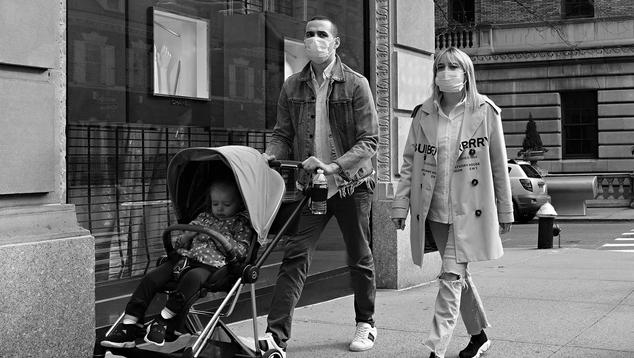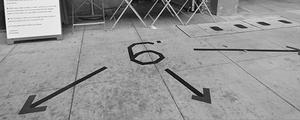Adults practicing social distancing generate at least 90% fewer contacts per day than those who are making little effort to social distance, according to new Gallup data. Those who completely or mostly isolate themselves generate about five contacts per day, compared with an average of 52 for those not attempting to isolate themselves.
According to the March 27-April 9 Gallup Panel survey, work is the largest source of close contact Americans have outside of household members, accounting for roughly half of all contacts. Working in retail, hospitality and manufacturing generates the largest number of contacts.
Yet, closing workplaces may not be the only way to mitigate contact and suppress viral transmission. Workers who visit their work site but have made changes in how they do their job reduced contacts by 29% to 69%.
Why Measuring Contacts Matters
In epidemiological models, social distancing has large effects on expected infection growth. Yet, different modeling teams have used varying assumptions for the efficacy of social distancing when it comes to reducing contacts. Getting these estimates right would thus appear crucial to accurately understanding the risks and rewards of different mitigation policies.
For example, in research published by public health scholars at Columbia University, these scholars have assumed that social distancing can reduce at most 40% of daily contacts. An influential model from Imperial College London defined "social distancing of the entire population" as reducing workplace contacts by 25%, household contacts by 25%, and social or nonwork contacts by 75%.
These parameters also require a baseline measure of average daily contacts. One widely cited study found an average of 13 contacts per person per day across eight European countries, but defined "contacts" as touching or conversation. Alternatively, in the Gallup Panel survey, we defined "contact" as coming within six feet of another person, which is consistent with the U.S. Centers for Disease Control and Prevention's guidelines on social distancing. We also asked a more subjective question about the extent to which people are attempting to isolate themselves.
Social Distancing Is Harder for Workers
As reported in previous Gallup articles, the majority of Americans (74%) have been mostly or completely isolating themselves from people outside their household since March 27, but isolation falls to 67% for workers, as opposed to 84% of nonworkers. Only 3% of adults and 4% of workers have not made any attempt to isolate themselves.
As with subjective reports of isolation, the mean number of total contacts with nonhousehold members is much larger for those who are working. Workers generate roughly 10 additional contacts per day compared with nonworkers (13.9 versus 4).
| All adults | Working adults | Adults not working | |||||||||||||||||||||||||||||||||||||||||||||||||||||||||||||||||||||||||||||||||||||||||||||||||
|---|---|---|---|---|---|---|---|---|---|---|---|---|---|---|---|---|---|---|---|---|---|---|---|---|---|---|---|---|---|---|---|---|---|---|---|---|---|---|---|---|---|---|---|---|---|---|---|---|---|---|---|---|---|---|---|---|---|---|---|---|---|---|---|---|---|---|---|---|---|---|---|---|---|---|---|---|---|---|---|---|---|---|---|---|---|---|---|---|---|---|---|---|---|---|---|---|---|---|---|
| Mean contacts | 9.9 | 13.9 | 4.0 | ||||||||||||||||||||||||||||||||||||||||||||||||||||||||||||||||||||||||||||||||||||||||||||||||
| Completely isolated yourself, having no contact with people outside your household | 27% | 23% | 32% | ||||||||||||||||||||||||||||||||||||||||||||||||||||||||||||||||||||||||||||||||||||||||||||||||
| Mostly isolated yourself, having very little contact with people outside your household | 47% | 44% | 52% | ||||||||||||||||||||||||||||||||||||||||||||||||||||||||||||||||||||||||||||||||||||||||||||||||
| Partially isolated yourself, having some contact with people outside your household | 17% | 19% | 13% | ||||||||||||||||||||||||||||||||||||||||||||||||||||||||||||||||||||||||||||||||||||||||||||||||
| Isolated yourself a little, still having a fair amount of contact with people outside your household | 7% | 10% | 1% | ||||||||||||||||||||||||||||||||||||||||||||||||||||||||||||||||||||||||||||||||||||||||||||||||
| Did not make any attempt to isolate yourself from people outside your household | 3% | 4% | 1% | ||||||||||||||||||||||||||||||||||||||||||||||||||||||||||||||||||||||||||||||||||||||||||||||||
| Gallup Panel, March 27-April 9, 2020 | |||||||||||||||||||||||||||||||||||||||||||||||||||||||||||||||||||||||||||||||||||||||||||||||||||
To estimate the effects of social distancing on the number of contacts, I calculated the median and mean number of contacts according to people's subjective assessments of their social distancing efforts -- that is, the number of people they estimate they came into close contact with (that is within six feet of) in the previous 24 hours.
Those who say they have made no attempt to isolate themselves generate a mean of 51.9 contacts and a median of 30. These are dramatically higher numbers than those for people who have either mostly or completely isolated themselves. Mean contacts for those who have mostly isolated themselves are 5.4, with a median of 2. Mean contacts are under 2 for those who report completely isolating themselves. It is possible that at least some respondents interpret this item as indicating their level of effort at avoiding contacts. Eighty percent of people who report completely isolating themselves report zero contacts, but others generate contacts through work or going to the store that they may regard as involuntary. Only 8% of people who say they made no attempt to isolate themselves report zero contacts. In any case, these comparisons suggest that isolation through social distancing could generate reductions in contact on the order of 90% or higher, though there are several reasons to be cautious in drawing this conclusion.
| Median nonhousehold contacts | Mean nonhousehold contacts | ||||||||||||||||||||||||||||||||||||||||||||||||||||||||||||||||||||||||||||||||||||||||||||||||||
|---|---|---|---|---|---|---|---|---|---|---|---|---|---|---|---|---|---|---|---|---|---|---|---|---|---|---|---|---|---|---|---|---|---|---|---|---|---|---|---|---|---|---|---|---|---|---|---|---|---|---|---|---|---|---|---|---|---|---|---|---|---|---|---|---|---|---|---|---|---|---|---|---|---|---|---|---|---|---|---|---|---|---|---|---|---|---|---|---|---|---|---|---|---|---|---|---|---|---|---|
| Completely isolated yourself, having no contact with people outside your household | 0 | 1.5 | |||||||||||||||||||||||||||||||||||||||||||||||||||||||||||||||||||||||||||||||||||||||||||||||||
| Mostly isolated yourself, having very little contact with people outside your household | 2 | 5.4 | |||||||||||||||||||||||||||||||||||||||||||||||||||||||||||||||||||||||||||||||||||||||||||||||||
| Partially isolated yourself, having some contact with people outside your household | 5 | 10.9 | |||||||||||||||||||||||||||||||||||||||||||||||||||||||||||||||||||||||||||||||||||||||||||||||||
| Isolated yourself a little, still having a fair amount of contact with people outside your household | 14 | 52.0 | |||||||||||||||||||||||||||||||||||||||||||||||||||||||||||||||||||||||||||||||||||||||||||||||||
| Did not make any attempt to isolate yourself from people outside your household | 30 | 51.9 | |||||||||||||||||||||||||||||||||||||||||||||||||||||||||||||||||||||||||||||||||||||||||||||||||
| Gallup Panel, March 27-April 9, 2020 | |||||||||||||||||||||||||||||||||||||||||||||||||||||||||||||||||||||||||||||||||||||||||||||||||||
One limitation of these data is that people who might normally have had more contacts may be more likely to reject social distancing or avoid it out of necessity. A better estimate would have been to compare an individual's contacts before the pandemic to contacts afterward, but those data are not available. Given that, we looked at a 2007 study of people living in Portland, Oregon, which estimated daily contacts at roughly 21 for middle-aged adults. If this is used as a baseline, it suggests that current compliance with social distancing (averaging five contacts per day) has induced large reductions in contacts, though not as dramatic as a decrease from 52 to five.
Where Contacts Occur
Since March 27, the majority of contacts for adults outside the household have occurred at work (52%), whereas a smaller but still large share have occurred at the grocery store (26%). No other category accounts for even 10%, but one's home is the third largest at 8%, or fewer than one contact per day, on average. If respondents work in grocery stores or other locations, they were asked to count those only as part of their workplace. These data suggest that closing workplaces is an important strategy to reduce disease transmission.
| Mean number of contacts | Share of contacts | ||||||||||||||||||||||||||||||||||||||||||||||||||||||||||||||||||||||||||||||||||||||||||||||||||
|---|---|---|---|---|---|---|---|---|---|---|---|---|---|---|---|---|---|---|---|---|---|---|---|---|---|---|---|---|---|---|---|---|---|---|---|---|---|---|---|---|---|---|---|---|---|---|---|---|---|---|---|---|---|---|---|---|---|---|---|---|---|---|---|---|---|---|---|---|---|---|---|---|---|---|---|---|---|---|---|---|---|---|---|---|---|---|---|---|---|---|---|---|---|---|---|---|---|---|---|
| Your place of work | 5.1 | 52% | |||||||||||||||||||||||||||||||||||||||||||||||||||||||||||||||||||||||||||||||||||||||||||||||||
| Grocery store | 2.6 | 26% | |||||||||||||||||||||||||||||||||||||||||||||||||||||||||||||||||||||||||||||||||||||||||||||||||
| Your house | 0.8 | 8% | |||||||||||||||||||||||||||||||||||||||||||||||||||||||||||||||||||||||||||||||||||||||||||||||||
| Other store | 0.4 | 4% | |||||||||||||||||||||||||||||||||||||||||||||||||||||||||||||||||||||||||||||||||||||||||||||||||
| Someone else's home or apartment | 0.3 | 3% | |||||||||||||||||||||||||||||||||||||||||||||||||||||||||||||||||||||||||||||||||||||||||||||||||
| Pharmacy | 0.2 | 2% | |||||||||||||||||||||||||||||||||||||||||||||||||||||||||||||||||||||||||||||||||||||||||||||||||
| Travel by airplane | 0.2 | 2% | |||||||||||||||||||||||||||||||||||||||||||||||||||||||||||||||||||||||||||||||||||||||||||||||||
| Doctor's office, hospital or treatment center | 0.2 | 2% | |||||||||||||||||||||||||||||||||||||||||||||||||||||||||||||||||||||||||||||||||||||||||||||||||
| Restaurant | 0.1 | 1% | |||||||||||||||||||||||||||||||||||||||||||||||||||||||||||||||||||||||||||||||||||||||||||||||||
| Public transportation | 0 | 0% | |||||||||||||||||||||||||||||||||||||||||||||||||||||||||||||||||||||||||||||||||||||||||||||||||
| Total | 9.9 | 100% | |||||||||||||||||||||||||||||||||||||||||||||||||||||||||||||||||||||||||||||||||||||||||||||||||
| Gallup Panel, March 27-April 9, 2020 | |||||||||||||||||||||||||||||||||||||||||||||||||||||||||||||||||||||||||||||||||||||||||||||||||||
The level of contact also varies widely across economic sectors. One obvious reason is that industries vary in whether the work can be done remotely. Most workers in retail or hospitality report that they have visited their workplace within the past 24 hours (56%). The same is true for manufacturing (59%) and transportation and warehousing (54%). Meanwhile, no more than about one out of four workers visited their workplace in the professional services, education, communications, and finance and real estate sectors.
As expected, these results are affected by the day of the week. Workers responding on a Thursday were the most likely to have visited their workplace within the previous 24 hours (44%), whereas workers responding on a Sunday were the least likely (29%). Those who completed the survey on Saturday expressed a relative likelihood of visiting work (43%), presumably because they included Friday as within the 24-hour period. The estimates, therefore, would be slightly higher if people who completed the survey on Sunday were excluded, though this does not significantly alter the rankings by industry.
For workers who do visit their workplace, retail/hospitality and manufacturing generate by far the most contacts, with mean contacts of 89 and 47, respectively. Workers in construction; professional services; communications, arts, design, and media; and education generate six or fewer daily close contacts.
| Median contacts at work | Mean contacts at work | ||||||||||||||||||||||||||||||||||||||||||||||||||||||||||||||||||||||||||||||||||||||||||||||||||
|---|---|---|---|---|---|---|---|---|---|---|---|---|---|---|---|---|---|---|---|---|---|---|---|---|---|---|---|---|---|---|---|---|---|---|---|---|---|---|---|---|---|---|---|---|---|---|---|---|---|---|---|---|---|---|---|---|---|---|---|---|---|---|---|---|---|---|---|---|---|---|---|---|---|---|---|---|---|---|---|---|---|---|---|---|---|---|---|---|---|---|---|---|---|---|---|---|---|---|---|
| Retail and hospitality | 15 | 89.4 | |||||||||||||||||||||||||||||||||||||||||||||||||||||||||||||||||||||||||||||||||||||||||||||||||
| Manufacturing | 5 | 46.7 | |||||||||||||||||||||||||||||||||||||||||||||||||||||||||||||||||||||||||||||||||||||||||||||||||
| Healthcare | 4 | 18.7 | |||||||||||||||||||||||||||||||||||||||||||||||||||||||||||||||||||||||||||||||||||||||||||||||||
| Transportation and warehousing | 6 | 14.9 | |||||||||||||||||||||||||||||||||||||||||||||||||||||||||||||||||||||||||||||||||||||||||||||||||
| Other services | 7 | 13.8 | |||||||||||||||||||||||||||||||||||||||||||||||||||||||||||||||||||||||||||||||||||||||||||||||||
| Government and social services | 4 | 9.9 | |||||||||||||||||||||||||||||||||||||||||||||||||||||||||||||||||||||||||||||||||||||||||||||||||
| Finance, real estate and insurance | 3 | 9.1 | |||||||||||||||||||||||||||||||||||||||||||||||||||||||||||||||||||||||||||||||||||||||||||||||||
| Agriculture, forestry, utilities and energy | 4 | 7.4 | |||||||||||||||||||||||||||||||||||||||||||||||||||||||||||||||||||||||||||||||||||||||||||||||||
| Communications, arts, design, media | 4 | 6.1 | |||||||||||||||||||||||||||||||||||||||||||||||||||||||||||||||||||||||||||||||||||||||||||||||||
| Construction | 3 | 6.1 | |||||||||||||||||||||||||||||||||||||||||||||||||||||||||||||||||||||||||||||||||||||||||||||||||
| Professional, technological and legal services | 2 | 4.3 | |||||||||||||||||||||||||||||||||||||||||||||||||||||||||||||||||||||||||||||||||||||||||||||||||
| Education* | 1 | 2.6 | |||||||||||||||||||||||||||||||||||||||||||||||||||||||||||||||||||||||||||||||||||||||||||||||||
| *Education includes library and training services. | |||||||||||||||||||||||||||||||||||||||||||||||||||||||||||||||||||||||||||||||||||||||||||||||||||
| Gallup Panel, March 27-April 9, 2020 | |||||||||||||||||||||||||||||||||||||||||||||||||||||||||||||||||||||||||||||||||||||||||||||||||||
Mitigation Efforts While at Work
Despite going to work, the large majority of workers (84%) who visit their workplace report that they have made changes to their job to avoid catching the virus. These changes appear to have reduced contacts. Those not taking steps have a mean number of 33 contacts, but those who have taken mitigation steps have 25 or 11 contacts on average, depending on the extent to which mitigation has made it harder to do their job.
| Median contacts | Mean contacts | ||||||||||||||||||||||||||||||||||||||||||||||||||||||||||||||||||||||||||||||||||||||||||||||||||
|---|---|---|---|---|---|---|---|---|---|---|---|---|---|---|---|---|---|---|---|---|---|---|---|---|---|---|---|---|---|---|---|---|---|---|---|---|---|---|---|---|---|---|---|---|---|---|---|---|---|---|---|---|---|---|---|---|---|---|---|---|---|---|---|---|---|---|---|---|---|---|---|---|---|---|---|---|---|---|---|---|---|---|---|---|---|---|---|---|---|---|---|---|---|---|---|---|---|---|---|
| Yes, and it has made it harder to do my job | 5 | 25 | |||||||||||||||||||||||||||||||||||||||||||||||||||||||||||||||||||||||||||||||||||||||||||||||||
| Yes, and it has NOT made it harder to do my job | 4 | 11 | |||||||||||||||||||||||||||||||||||||||||||||||||||||||||||||||||||||||||||||||||||||||||||||||||
| No, have not made changes | 5 | 33 | |||||||||||||||||||||||||||||||||||||||||||||||||||||||||||||||||||||||||||||||||||||||||||||||||
| * Item states: "Have you made any changes in how you do your job in order to avoid catching the coronavirus, or not? | |||||||||||||||||||||||||||||||||||||||||||||||||||||||||||||||||||||||||||||||||||||||||||||||||||
| Gallup Panel, March 27-April 9, 2020 | |||||||||||||||||||||||||||||||||||||||||||||||||||||||||||||||||||||||||||||||||||||||||||||||||||
In summary, these data provide evidence that the self-isolating practices of most Americans are dramatically reducing daily contacts when compared with pre-pandemic estimates of daily contacts from people who are making little effort to isolate themselves.
Work generates the majority of contact, with contacts particularly high in retail and hospitality, which have been mandated to close down through much of the country. Manufacturing workers, who may be making essential products, also generate a large number of contacts relative to workers in other industries, and their jobs are more likely to require in-person work. Fortunately, workers making an effort to change how they do their job appear to mitigate the number of contacts by significant margins. This suggests that reopening businesses could be consistent with disease suppression. Gallup will continue to monitor and report on the practices workers and businesses have adopted to reduce disease transmission.




